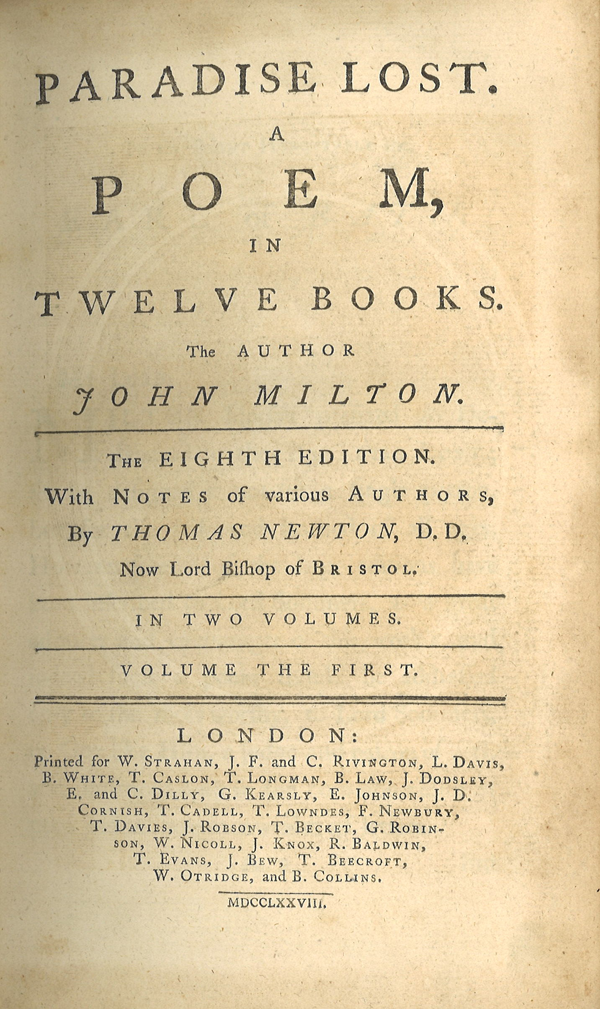

Paradise Lost by John Milton, Edited by Thomas Newton

Paradise Lost is one of the most foundational works of Christian literature to date. Written by scholar, clergyman, and poet John Milton in 1667, Paradise Lost is a reimagining of the story of Adam and Eve, using epic poetic form to recount Satan’s fall from grace and the first couple’s exile from the Garden of Eden. The epic poem follows in the footsteps of past works like Homer’s Iliad and Virgil’s Aeneid in terms of its grand scale and style. Likewise, it has become a part of western consciousness and an inspiration for many works of art and literature. It has been so influential that many people believe that the serpent who tempted Adam and Eve to eat from the Tree of Knowledge was Satan. This was actually an invention of Milton’s imagination, merging the cunning serpent from the Bible with Satan to imply a darker temptation.
Milton was born in London, England, in 1608, and is regarded as one of the greatest English poets. He was a scholar who studied throughout his entire life even after his vision began to fade. He was completely blind by the age of forty. Against his original intent, he lived as a reclusive scholar for his own safety after making many enemies with his vocal objections to the monarchy. He continued voicing his controversial thoughts with his prose almost a month before King Charles II’s coronation in 1661 during the Restoration period. It was during his seclusion that he wrote his masterpiece, Paradise Lost. He divided his epic into ten sections that he called “books,” not to be confused with actual physical copies. Often the epic was contained in one or two bound volumes, depending on the printer. After the end of the Restoration period and in relative safety, he enjoyed numerous visitors, composed his final works, and died quietly in 1674. Before his death that same year, he reissued Paradise Lost in twelve books instead of his original ten.
The poem had a difficult past regarding publication in the early years after its composition. Numerous editors took great liberties with the original text since its initial publication, and since 1678 publishers began to take even more liberties with Milton’s language by making more changes to the poem. Dr. Thomas Newton, a clergyman and scholar born in Lichfield, Staffordshire, England in 1608, sought to edit a new edition of Paradise Lost that was as close to the original text as possible.
Without any access to Milton’s first manuscript, Dr. Newton was the first to go back to the 1674 text of Paradise Lost. It was considered an authoritative text published within Milton’s lifetime, and Dr. Newton used it as a basis for his edited edition in 1749. He chose Milton’s text so that he could painstakingly review each line of the epic to correct eighty-two years of changes from other publishers. When Newton’s first edition of Paradise Lost was published, he was the Minister of York. By the time the final reprinting of his edited version of the epic was published, Dr. Newton had become the Bishop of Bristol.
Dr. Newton’s edited version of Paradise Lost is divided into twelve books just as Milton’s 1674 reissue of the epic was. The twelve-book format is still the standard for modern editions today, though they are now often bound in one single copy rather than multiple bound volumes. Newton’s edition was the first definitive printing to go back to Milton’s own language. It served as the standard that nearly all subsequent editors and publishers would look to through the late eighteenth century and most of the nineteenth century. Between 1749 and 1790, Newton’s edition was printed nine times and was the most popular edition available.
Special Collections at The University of Southern Mississippi has a two-volume copy of Dr. Thomas Newton’s 8th edition of Paradise Lost by John Milton, published in 1778. If you would like to view these books, visit the reading room on the third floor of McCain Library & Archives from 9am – 4pm Monday-Friday.
If you have any questions, contact Jennifer Brannock at Jennifer.Brannock@usm.edu or 601.266.4347.
Sources Consulted
Bensen, R. (1999) John Milton. Dictionary of World Biography: The 17th & 18th Centuries, 1-4. Accessed June 16, 2021. Retrieved from: Literary Reference Center, http://search.ebscohost.com/login.aspx?direct=true&db=lfh&AN=103331DWS10400250000140&site=lrc-live
Clergy of the Church of England Database (2021): Person: Newton, Thomas (1729-1782). Clergy of the Church of England Database. Accessed June 8, 2021. Retrieved from: https://theclergydatabase.org.uk/jsp/persons/CreatePersonFrames.jsp?PersonID=109210
Moyles, R. G. (1985) The text of Paradise Lost: A study in editorial procedure. University of Toronto Press.
Text by Phillip Snyder, Practicum Student and SLIS Graduate Student.